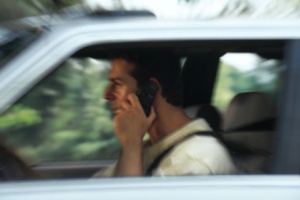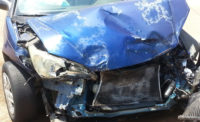 Posted with permission from FairWarning.org:
Posted with permission from FairWarning.org:
Saying it is “passionate” about the safety of young drivers, Ford Motor Co. is sponsoring clinics at U.S. high schools to urge teens to heed traffic laws and avoid distractions behind the wheel. The auto giant, as part of its “Driving Skills for Life” program, also recently awarded $25,000 to students who created the best music video about the hazards of distracted driving.
Likewise, BMW has launched ‘Don’t Text and Drive,’ a series of ads to dramatize the risks of distracted driving. And the Alliance of Automobile Manufacturers, an industry trade group, is teaming with the American Academy of Orthopaedic Surgeons in a similar campaign.
Through efforts like these, automakers are positioning themselves as leaders in the fight against distracted driving, which federal authorities estimate caused 5,474 deaths in 2009, including 995 from using cellphones.
But even as they tell drivers to act responsibly and pay attention to the road, the companies are seeking to pump up sales by packing their new models with cutting-edge infotainment systems that encourage multi-tasking behind the wheel.
Ford’s SYNC system, for example, enables drivers to use voice commands and touch screens to make and receive calls, listen to their text messages, and choose from a menu of replies. BMW’s ConnectedDrive provides calling, e-mail and text read-backs, and displays headlines of the messages on a screen.
General Motors strutted its stuff with a Super Bowl ad of a young Chevy Cruze owner whose face lights up as he drives away and plays back the Facebook message: “Best first date ever…’’
Auto executives are counting heavily on arresting, high-tech features to boost sales, especially to younger buyers. David Mondragon, president of Ford Canada, put it bluntly: “The biggest turnoff to a twentysomething consumer is to put their life on hold when they sit in a car,” he said in a speech to the Canadian Marketing Assn., according to an account in The Globe and Mail.
“And what does it mean to put their life on hold? To get disconnected when they get in the car, to have a system that will not allow you to sit there and e-mail, read your BlackBerry, talk on the phone. So you have to have a seamless transition from your home to your transportation device, to your workspace. Or to your play space.” (Mondragon, through a spokeswoman, declined to be interviewed.)
Safety officials are worried about the trend. “I’m not in the business of helping people Tweet better,” groused David Strickland, head of the National Highway Traffic Safety Administration, or NHTSA, in a speech at a national conference in June.
Critics say that in highlighting distracted driving, automakers are hoping to inoculate themselves against tough scrutiny of their built-in systems. “The best defense is a good offense,” said Clarence Ditlow, executive director of the Center for Auto Safety in Washington, D.C. “One has to watch what auto companies do, versus what they say. While they say distracted driving is unsafe, they are making hundreds of millions of dollars by selling distracted driving technology.”
Industry officials, however, deny they are sending a mixed message about distracted driving. They say that drivers are so intent on staying connected that telling them to turn off their devices is a lost cause. By giving motorists built-in connections that are simpler and less distracting than portable devices such as cellphones and GPS, they say they are making the roads safer.
“Given that the driver has decided they are going to do something, it’s better to be doing it with their eyes on the road and their hands on the wheel,” said Louis Tijerina, senior technical specialist in research and advanced engineering at Ford.
In fact,“Eyes on the road, hands on the wheel,” has become an industry mantra, particularly for Ford. More than a marketing slogan, it presents a fundamental challenge to the long-held precept that distraction involves not only the eyes and the hands, but the mind.
NHTSA’s official position, backed by a body of research, is that there are three types of distraction: visual, manual and cognitive. That is, even when a motorist is looking straight ahead, the cognitive demand of a phone conversation may cause “inattention blindness,” or a failure to respond to visual cues because the mind is somewhere else.
The evidence includes a study by the Insurance Institute for Highway Safety that found that drivers are four times more likely to crash when they are talking on the phone, whether using a hand-held or hands-free device.
Researchers at the University of Utah found that cellphone conversations slow drivers’ reactions as much as having a blood alcohol level at the legal limit of .08 percent. Moreover, in some fatal cellphone crashes, there is anecdotal evidence that drivers were simply talking — not dialing or groping for their phones.
However, automakers say that drivers have always multi-tasked, and can do it safely if they keep their eyes on the road. They have drawn ammunition from other research, including studies by the Virginia Tech Transportation Institute. These studies have found that visual and manual tasks can be serious distractions, but that there is little crash risk when drivers have their eyes on the road, “regardless of any other ‘cognitive demand,’ “ as one paper put it.
Even if on-board systems are better than portable devices, there is a question of whether they will become an ever-present temptation and cause drivers to “spend more time distracted in some way,” said Adrian Lund, president of the insurance institute.
“The honest answer is, we don’t know. This is an experiment we’re all in.”
The experiment is taking place in a regulatory vacuum, since there are no regulations to draw the line on electronic distractions.
Federal safety rules dictate the minimum strength of vehicle roofs and door latches, the performance of seat belts and airbags, the brightness of headlamps and stopping power of brakes. But when it comes to the design of electronic systems, vehicle makers are completely on their own.
It’s been that way since NHTSA, a decade ago, challenged the industry to use its best judgment and do the right thing. As Jeffrey Runge, NHTSA administrator during the George W. Bush presidency, put it in 2003: “We cannot regulate fast enough to keep up with technological advances, nor would we want to. This administration will always prefer voluntary brilliance to enforced compliance.”
“I understand that people get bored, they have other things they want to do, but they can pull over and do those without endangering the public.”
– Henry Jasny, Advocates for Highway and Auto SafetyAutomakers responded by developing a set of voluntary guidelines. Among other things, they call for placing displays high enough that drivers can see them and scan the road at the same time.
They also provide that electronic tasks be simple enough that drivers can perform them without looking away from the road for more than two seconds at a time. That means that the most complex tasks, such as typing requests for directions, may be locked out when a car is in motion. Even so, a car traveling at 60 miles per hour covers 176 feet in two seconds — plenty of time for a deer, or a child, to run onto the road.
There has never been an independent review of the guidelines, nor monitoring of the companies’ compliance.
But under Transportation Secretary Ray LaHood, who has called distracted driving “a deadly epidemic,” federal authorities are becoming more active.
NHTSA is developing its own set of guidelines, and this fall plans to publish the first phase — addressing visual and manual distractions. Guidelines for voice controls and portable devices will be covered in future phases. Portable electronics pose a special challenge because NHTSA has no legal authority over devices drivers bring into their cars.
But some fear it may be too late for regulators to assert control.
Henry Jasny, vice president and senior counsel for Advocates for Highway and Auto Safety, said that as long ago as the 1990s, his group urged NHTSA to prepare for an onslaught of high-tech electronics. Now, they’ve let ‘’the animals get out of the barn,” said Jasny, “and it may not be possible to get them back in.”
Meanwhile, automakers say that work by the Virginia Tech Transportation Institute has shown they’re on the right track.
The Blacksburg, Va., research center has extensive contracts with federal transportation agencies and private clients, including several automakers. For example, GM and Ford hired it to compare the safety of drivers using their built-in systems instead of portable devices. The built-in systems came out on top, and both automakers issued press releases to tout the favorable results.
The institute has pioneered the use of “naturalistic studies,’’ conducted by mounting cameras and sensors in vehicles to see what drivers were doing at the time of crashes, near-crashes, or lesser incidents such as veering out of lanes.
While the studies confirmed risks from drivers using electronic devices, they found that nearly the entire risk stems from dialing, texting or reaching for a phone or other device — and almost none of it from talking.
In one study of commercial truck and bus drivers, researchers reached the provocative conclusion that wireless conversations had a “protective effect.” That is, the crash risk dropped when drivers were on the phone.
The institute prepared safety tips that are posted on the website of the Federal Motor Carrier Safety Administration, which regulates commercial trucking. One of them is: “Turn Off Your Cell Phone While Driving.” Rich Hanowski, director of the institute’s Center for Truck and Bus Safety, said that in light of the institute’s research findings it will recommend softening the warning. (The National Transportation Safety Board earlier this month reached a much different conclusion, recommending that the motor carrier agency prohibit use of cellphones by commercial truckers.)
But to suggest “there’s no such thing as cognitive distraction…is obviously not right,” said David Strayer, a University of Utah researcher and co-author of the study that compared cellphone use with having a blood alcohol level of .08. “They’re really postulating a model that would run counter to the way we, as cognitive scientists, know how the brain works.”
Safety groups insist the best advice for drivers is still to turn off their devices.
“We just don’t get why people should be encouraged not to pay attention to the driving task,” Jasny said. “I understand that people get bored, they have other things they want to do, but they can pull over and do those without endangering the public.”
About FairWarning
FairWarning (www.fairwarning.org) is a nonprofit, online news organization focused on issues of safety, health and government and business accountability.

 Myron Levin founded FairWarning after more than 20 years as a staff writer for the Los Angeles Times, where he was a member of the California investigations desk. He has won numerous honors and awards for his detailed investigations of health and safety matters, including an Alicia Patterson Foundation fellowship and the National Press Club’s Consumer Journalism Award. He has reported on the tobacco industry, auto and tire safety, and a variety of product liability issues. He likes hiking and playing racquetball, and he owns a minuscule share of a professional minor league baseball team. Myron is a member of FairWarning’s board of directors.
Myron Levin founded FairWarning after more than 20 years as a staff writer for the Los Angeles Times, where he was a member of the California investigations desk. He has won numerous honors and awards for his detailed investigations of health and safety matters, including an Alicia Patterson Foundation fellowship and the National Press Club’s Consumer Journalism Award. He has reported on the tobacco industry, auto and tire safety, and a variety of product liability issues. He likes hiking and playing racquetball, and he owns a minuscule share of a professional minor league baseball team. Myron is a member of FairWarning’s board of directors.

